As organizations handle more and more data—often referred to as the new gold—the stakes for choosing the right architecture are higher than ever. Make the wrong choice, and you’re not just facing inefficiency; you’re risking your entire data strategy. The wrong approach is the direct way to silos, bottlenecks, and security nightmares that will leave you stuck with unmanageable systems that drain your resources. Navigating the ‘data approach’ decision is not something to leave to chance. It requires the right expertise, tested approaches, and solid mechanics.
Modern organizations typically choose between three proven options for their Data Architecture: Data Fabric, Data Lake, and Data Warehouse. Each brings unique strengths to the table, so in this piece, we offer you to discover and answer the question of which one is right for you.
What is a Data Warehouse?
Let’s start with the most traditional architecture on the market. In short, a Data Warehouse is an environment optimized for storing and analyzing structured data. Firstly, data warehouses collect it from various sources, such as transactional systems like CRMs or ERPs. Once inside the warehouse, data undergoes the extract, transform, and load (ETL) process, where solutions like Informatica or Microsoft SSIS clean and prepare it for analysis. The data is then stored in relational databases such as MySQL, Oracle Database, or Microsoft SQL Server, structured in tables with rows and columns.
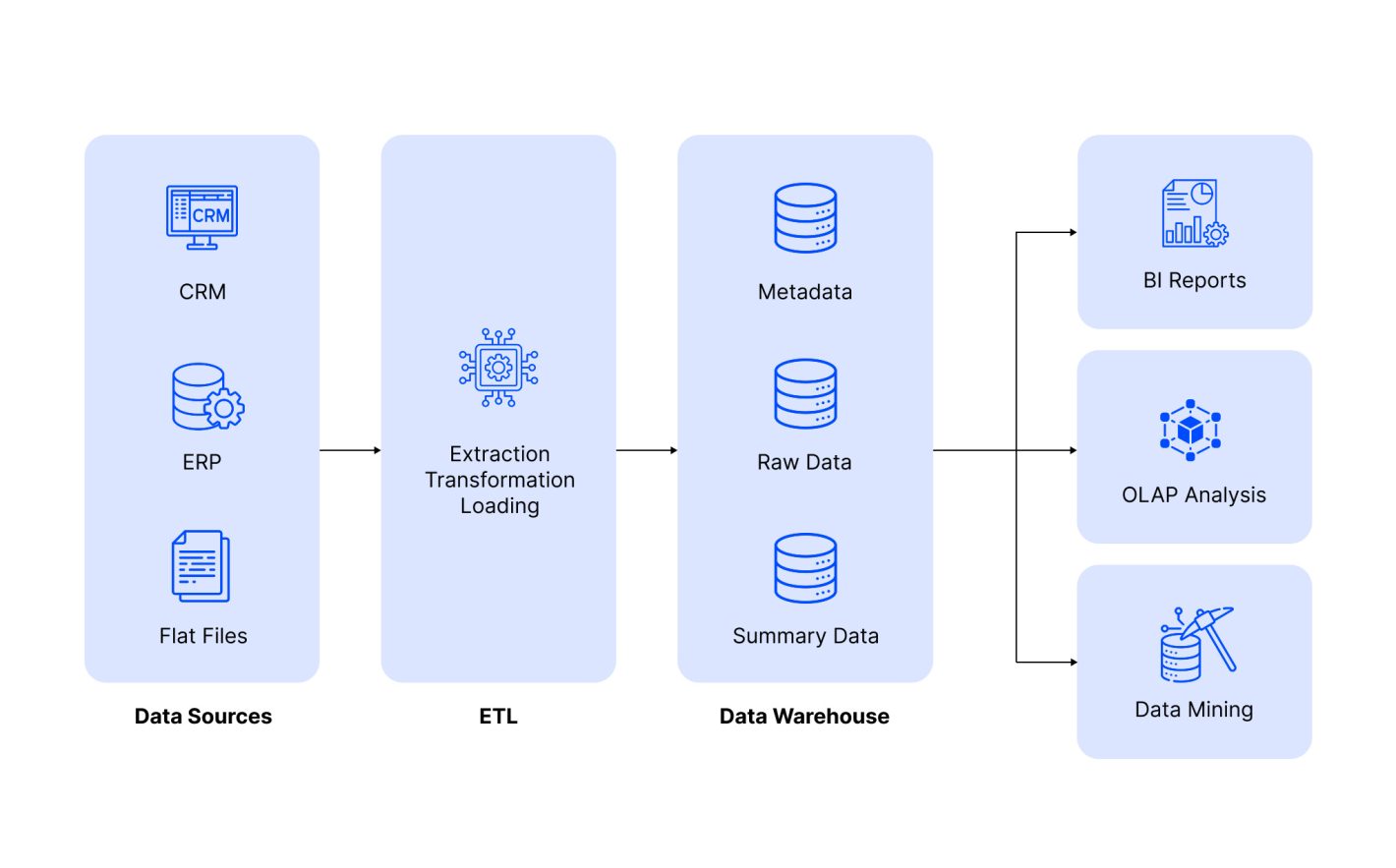
Data warehouse schema
Data Warehouses have existed since the 1980s. However, their popularity grew from decade to decade alongside the data-driven movement in business, especially in industries where reporting and compliance are critical. Modern cloud-based solutions like Amazon Redshift, Google BigQuery, and Snowflake have further revolutionized this architecture, offering more scalability and flexibility to the clients. These advancements, coupled with powerful visualization tools like Power BI and Tableau, allow organizations to get deeper insights and make data-driven decisions with greater agility.
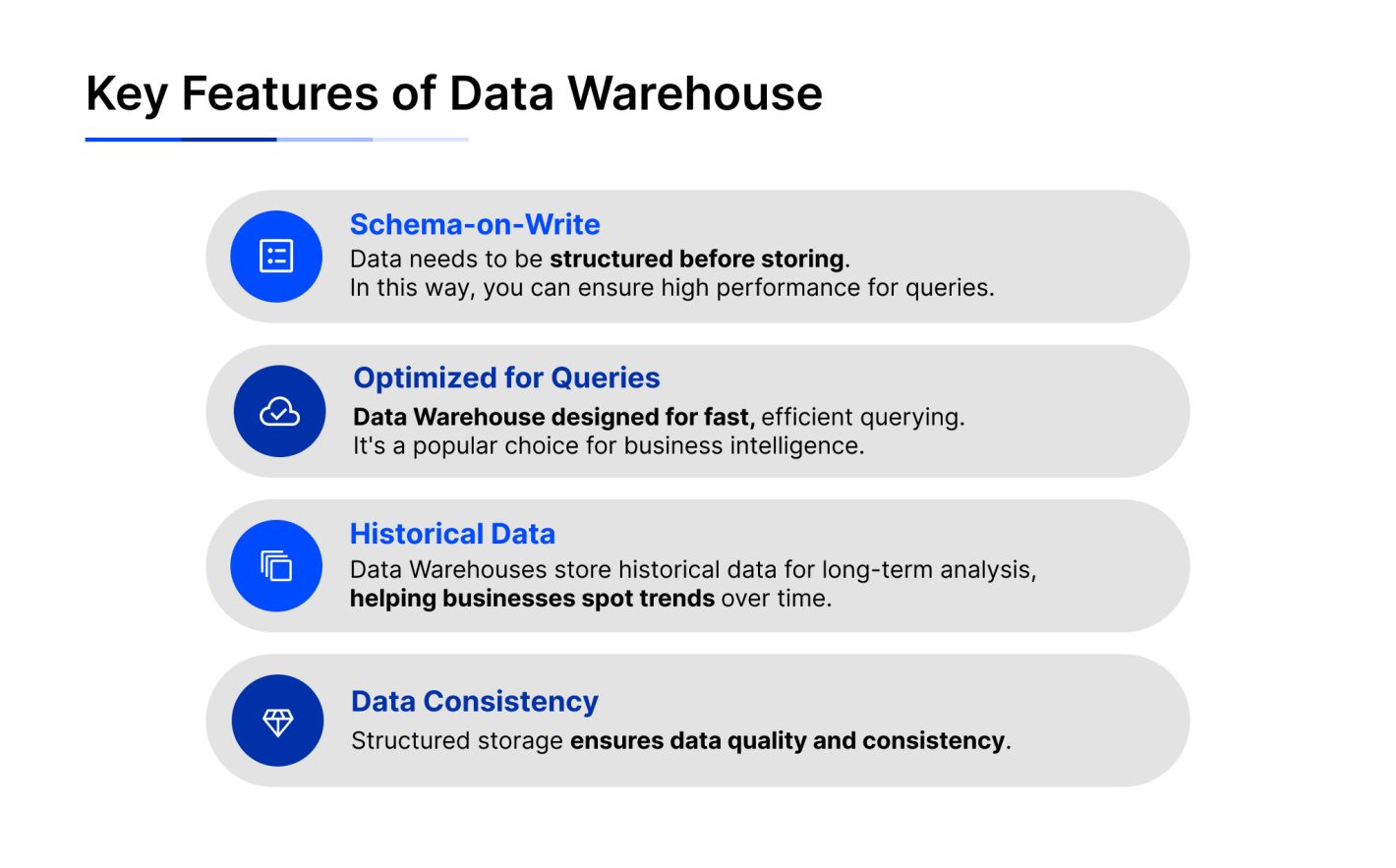
4 key data warehouse features
Typical Use Cases:
- Business Intelligence and Reporting: Data Warehouses are excellent at creating dashboards and reports.
- Structured Data Analysis: Warehouses are perfect for environments where the data is well-organized, such as sales figures or financial records.
- Regulatory and Compliance Reporting: Data Warehouses are about consistency and accuracy, so they can handle even the most strict compliance requirements.
How we did it at Sombra for Our Customers
Our client, an eClinical technology company, partnered with us to revamp their data engineering infrastructure. By implementing a modernized architecture and cutting-edge cloud solutions, we reduced their data pipeline costs by 50% and enabled near real-time reporting with a 2-minute delay—up from a previous 2-hour delay. Our robust data processing and security measures also improved data pipeline reliability to 99.9%, empowering the client to make faster, more accurate data-driven decisions.

What is a Data Lake?
Unlike a Data Warehouse, which requires only structured data organized into tables and columns, our next architecture enables more flexibility. It’s Data Lakes.
A Data Lake can be defined as a large repository that stores vast volumes of data in its original format, without the need for initial transformation. Just as a physical lake collects water from various sources—such as rivers, rain, and groundwater—making it possible for these different forms to coexist, a Data Lake can accept data from a variety of sources in multiple formats, whether they are raw, semi-structured, or unstructured. This data can include text, images, videos, logs, and more. Due to this flexibility, Data lakes are particularly used for machine learning, big data analytics, or advanced data science projects.
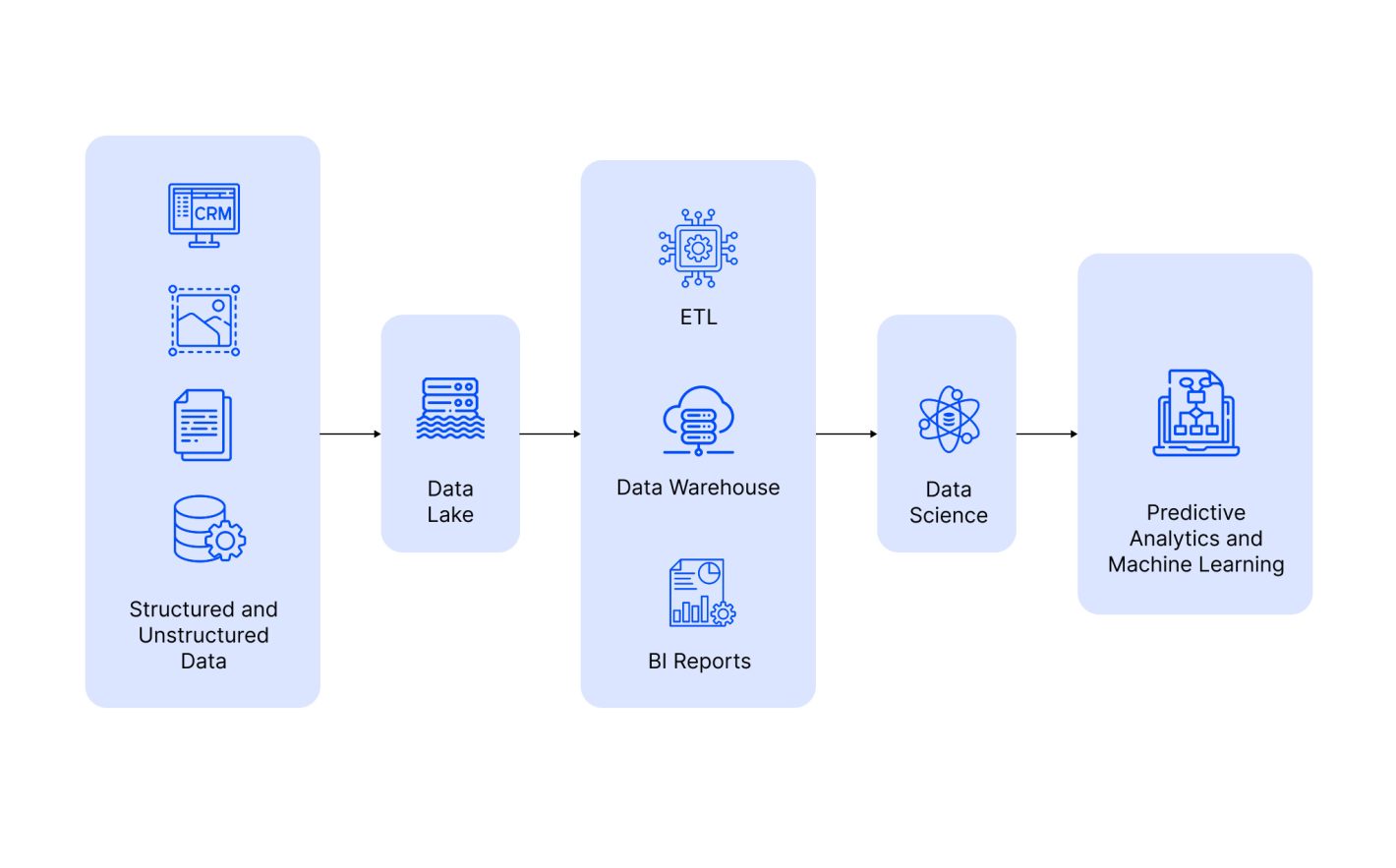
Data lake schema
The structure of a data lake can vary depending on the technologies being used, like Hadoop Distributed File System (HDFS), Apache Spark, or NoSQL databases. But in general, a data lake consists of multiple data sources feeding into it, the raw data repository (the lake itself), and tools that help process and transform this data for moving to other systems like a data warehouse for further use. A data lake encompasses key features such as metadata management, data asset catalogs, permission controls, lifecycle management, and tools to ensure data quality.
Data Lakes became popular in the early 2010s with the rise of big data. Back then, companies struggled to manage the flood of information coming from sources like social media, IoT devices, and transaction logs. Today, with the volume of data growing at about 23% per year, Data Lakes offer an efficient way to store diverse data types.
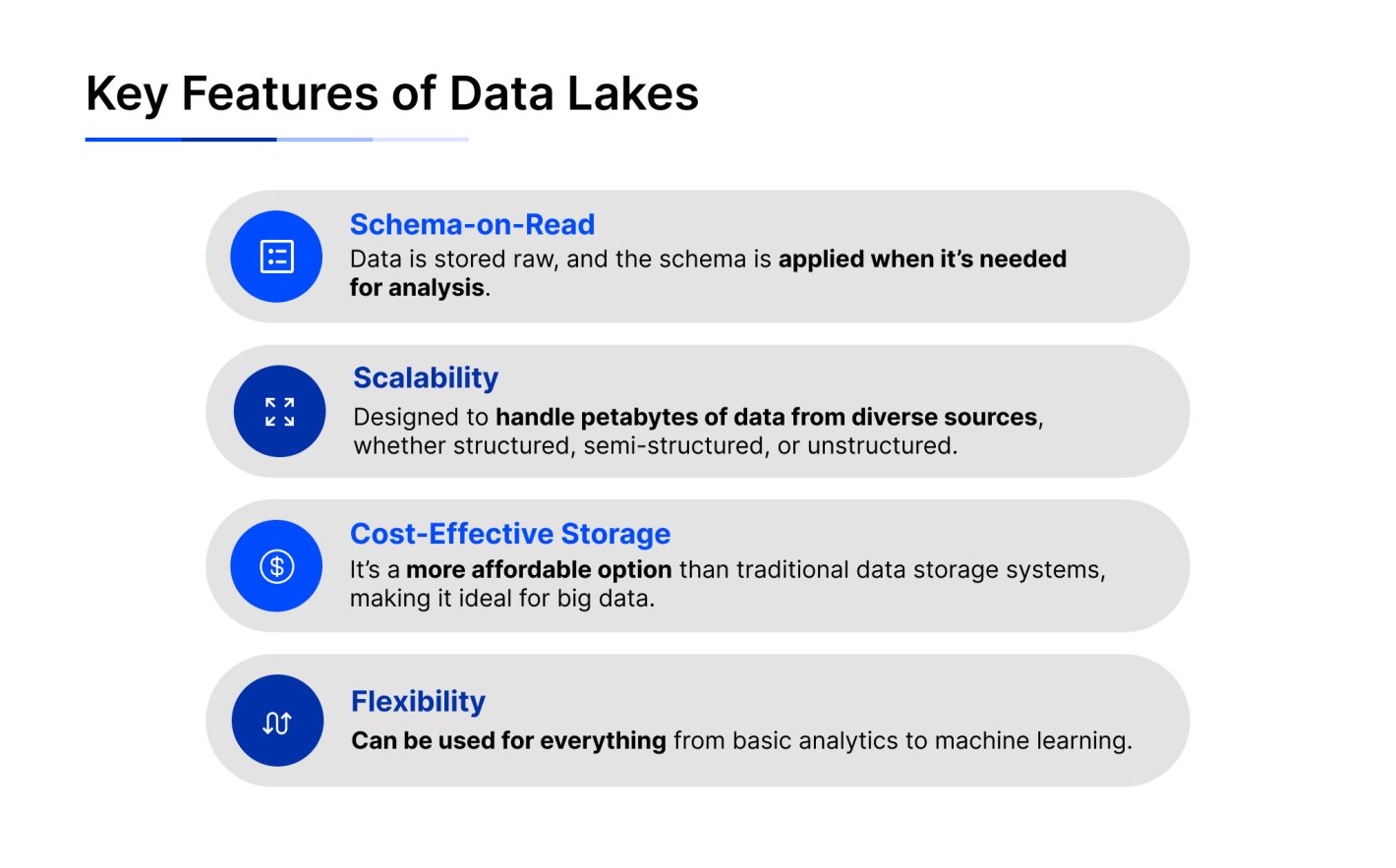
4 key data lake features
Typical Use Cases:
- Big Data Analytics: Ideal for storing and analyzing large datasets, such as IoT data or social media analytics.
- Machine Learning: Data Lakes provide a wealth of information for training machine learning models.
- Data Exploration: Allows data scientists to explore raw data before deciding how to use it.
For businesses looking to create or optimize a Data Lake infrastructure, Sombra offers bespoke data architecture solutions that scale as per your organization’s growing needs.
How we did it at Sombra for Our Customers
Our client, a U.S.-based agricultural investment firm, sought a unified data solution to improve data accessibility and visualization for decision-making. By implementing a robust data architecture with secure, near-real-time processing, we helped create a comprehensive platform that increased customer satisfaction (CSAT) by 70%, empowered investor collaboration, and streamlined reporting and data visualization for agricultural insights.

What is Data Fabric?
Finally, the newest architecture type – Data Fabric. It helps companies manage and integrate data across various environments, including, but not limited to, on-premise, in the cloud, or at the edge. The main benefit of Data Fabric is its ability to unify data access, no matter where it resides.
In simple terms, think of Data Fabric as a system that connects all the dots (data), making it easier to access and integrate. Such an approach solves silos and management challenges by implementing AI, machine learning, and data virtualization into the management process.
As already mentioned, Data Fabric, in its core, provides a unified access layer across all of an organization’s infrastructure. It can integrate data from diverse sources in real time, including information from cloud platforms, web apps, and IoT devices. Like data Lakes, Data Fabrics can use tools like metadata management and data catalogs to provide proper data governance, security, and compliance.
The architecture of Data Lakes uses APIs and SDKs to make data accessible for BI tools and analytics platforms like Tableau or Power BI to set up real-time analytics. Additionally, the concept of Data Fabric includes the possibility of connecting data lakes, data warehouses, and edge data systems into one scalable environment.
With the rise of complex data environments, Data Fabric is becoming essential. As analytics state, the global data is expected to reach 175 zettabytes, and businesses need efficient ways to manage it. Data Fabric’s AI-driven automation and integration are often seen as a key to handling this surge.
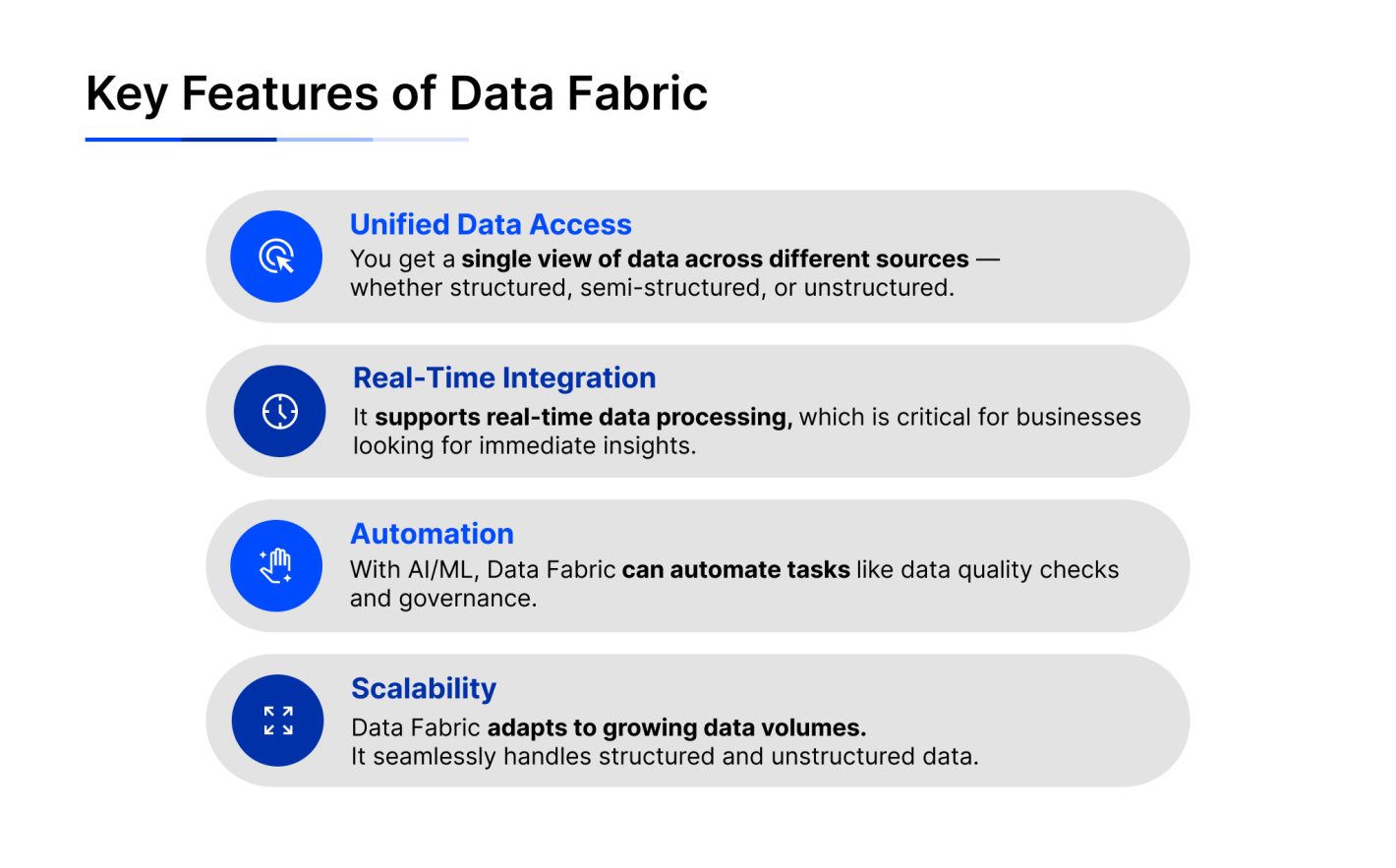
4 key data fabric features
Typical Use Cases:
- Hybrid and Multi-Cloud Environments: When your data is spread across multiple platforms, data fabric consolidates it.
- Real-Time Analytics: In retail and finance, where instant insights can lead to better decisions.
- Data Governance and Compliance: Automates governance to ensure security and compliance, especially in regulated sectors like healthcare.

Data Fabric vs. Data Lake vs. Data Warehouse
Each architecture has its strengths. Let’s recap their differences:
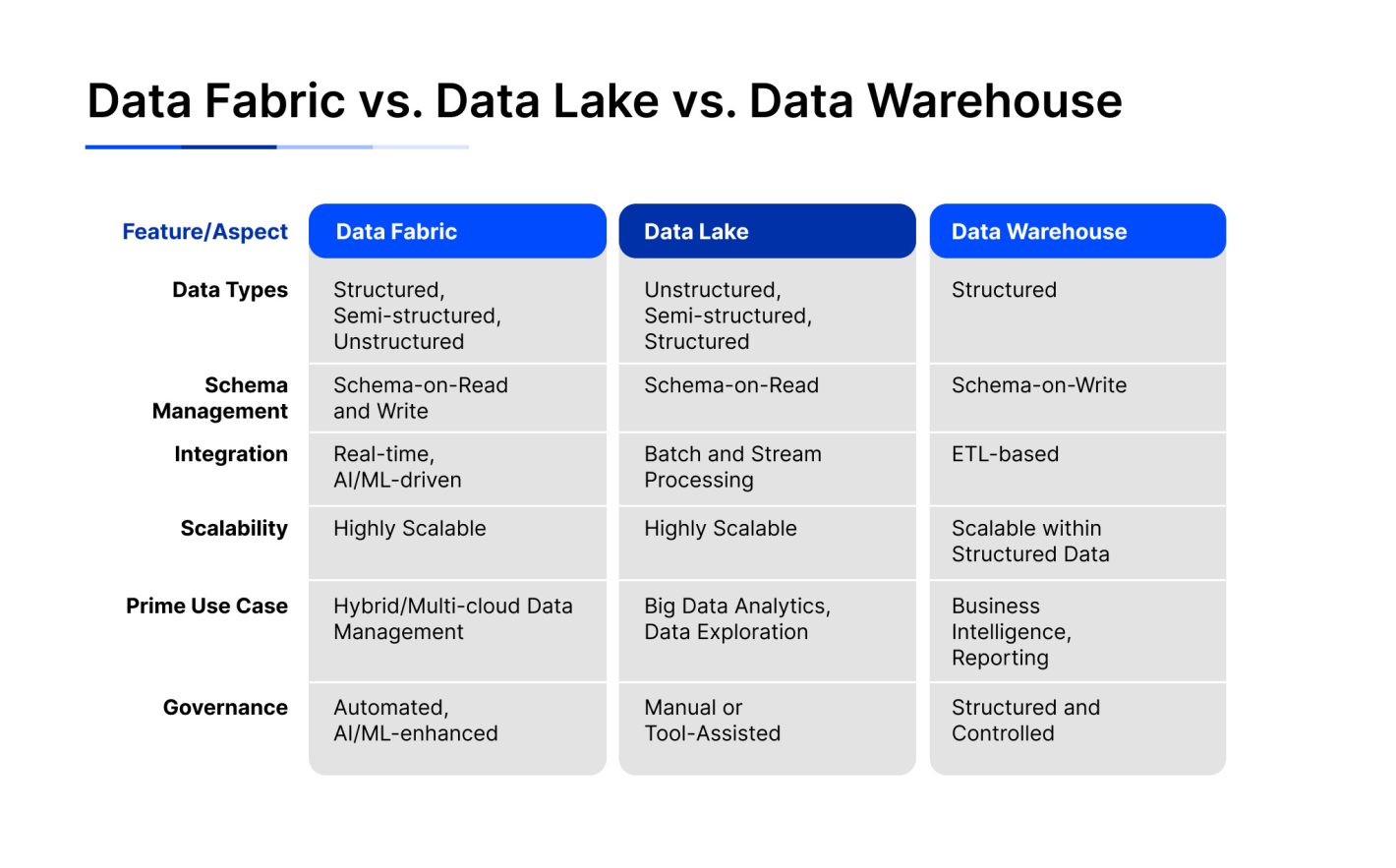
Data lake vs. data fabric vs. data warehouse
When to Choose Each
Choosing the right architecture depends on your organization’s data needs. Here’s when each might be the best fit:
- Data Fabric: This is ideal for businesses managing complex data environments, including hybrid and multi-cloud setups. It excels in real-time analytics and offers advanced automation for governance.
- Data Lake: If your organization deals with large amounts of unstructured or semi-structured data, such as logs or IoT sensor data, a Data Lake can provide a scalable, flexible solution. It’s particularly useful for big data analytics and machine learning applications.
- Data Warehouse: Perfect for businesses that rely on structured data for business intelligence and reporting. A Data Warehouse ensures fast, reliable access to clean, organized data, making it ideal for regulatory reporting and long-term analysis.
Hybrid Approach: Combining Data Fabric, Data Lake, and Data Warehouse
In many cases, these architectures are not mutually exclusive. Organizations can benefit from leveraging all three approaches—Data Fabric, Data Lake, and Data Warehouse—depending on their data strategy. Here’s how they can work together:
- Staging with a Data Lake: A Data Lake serves as a central repository for raw data. For instance, you could store unstructured data like weblogs, transaction data, and sensor readings in a Data Lake.
- Processing in a Data Warehouse: Once you have raw data in the Data Lake, you can feed it into a Data Warehouse for structured analysis and reporting. This helps transform raw data into usable formats for generating business reports.
- Integration and Governance with Data Fabric: A Data Fabric overlays both, providing a unified data management system that automates data integration, governance, and access across the entire organization. It connects disparate systems and enables real-time analytics.
If you want to know how to build the right infrastructure for your particular case, feel free to ask Sombra’s team.
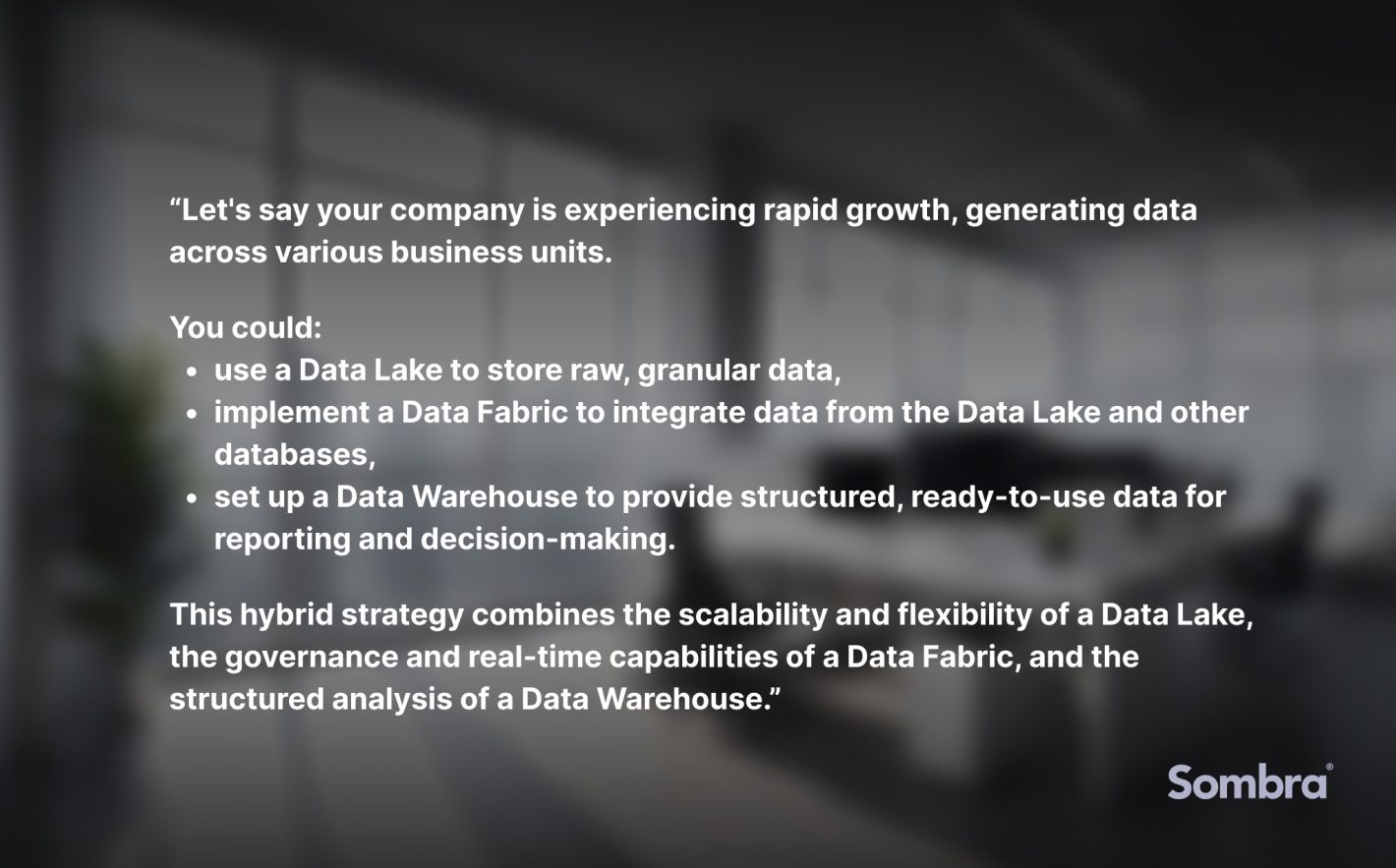
Evaluating Your Organization’s Needs: Data Maturity Survey
Determining which architecture is right for your organization often comes down to understanding your data maturity—that is, how advanced your organization is in managing and using data. Conducting a Data Maturity Survey can help you assess where you stand. Here are some key questions to ask:
1. Data Collection and Storage:
- What types of data are you currently collecting (structured, unstructured, semi-structured)?
- How large is your data volume, and is it expected to grow significantly?
- How scalable is your current data storage infrastructure?
2. Data Quality and Governance:
- How do you ensure the quality and accuracy of the data you collect?
- Do you have robust data governance policies in place?
- How do you manage data privacy and security?
3. Data Integration and Accessibility:
- How well is your data integrated across different sources?
- How easily can teams access the data they need for decision-making?
- Are you able to manage changes in data structures effectively?
4. Data Usage and Analytics:
- How often is data used in decision-making processes?
- Are you leveraging advanced analytics, like AI and machine learning, for deeper insights?
- How frequently do you run data analysis or reports?
5. Data Culture:
- Is there a strong data-driven culture within the organization?
- Are employees encouraged to use data in their roles?
- What is the level of data literacy across teams?
6. Data Strategy and Future Goals:
- Do you have a clear data strategy?
- What are the future data needs of your organization, and how do you plan to evolve your capabilities?
By answering these questions, you can better understand whether you need a Data Fabric for real-time integration and governance, a Data Lake for storing raw, unstructured data, or a Data Warehouse for structured data analysis. As we said before, most organizations, especially those growing quickly, will benefit from combining these approaches.
Final Thoughts on Data Management Solutions
Choosing between a Data Lake, Data Fabric, or Data Warehouse involves assessing your business’s current and future data needs. Data Lakes offer flexibility and are best for exploratory analysis. Data Warehouses provide high-performance query capabilities for structured data, while Data Fabrics excel in creating an integrated, real-time data environment.
Sombra offers comprehensive data management services to help implement the right data architecture for your business. Whether you’re looking to utilize a Data Lake, Data Warehouse, or Data Fabric, we have the expertise to support your goals. Additionally, we offer tailored solutions for the finance and energy sectors, where an effective data strategy is crucial for operational success.











